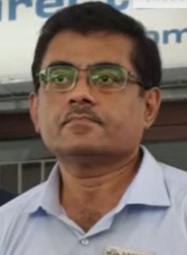H.P. Sanghvi, the Director of FSL, Gandhinagar: Collecting samples from the remains of the deceased, is very complex and requires greater precision. This entire process is highly complex and time-consuming.

FinTech BizNews Service
Mumbai, June 15, 2025: Shri H.P. Sanghvi, the Director of Forensic Science Laboratory (FSL), Gandhinagar, has provided very interesting detailed information regarding the process of DNA profiling and matching in connection with the plane crash in Ahmedabad.

He stated that the process, from sampling of the deceased passengers' family members to DNA matching, is being carried out continuously for 24 hours. Providing insights into the DNA profiling and matching process, he explained that there are primarily two methods of obtaining DNA samples. One method involves collecting samples from fresh blood, which is not a complex process. The other method involves collecting samples from the remains of the deceased, which is more complex and requires greater precision. Samples collected from the remains are carefully cleaned to avoid external contamination.
He added that during the DNA isolation and extraction process, if the sample includes a bone, it is ground into a powder. If the sample includes a tooth, it is broken into small pieces and then powdered. The powdered sample is then subjected to a precise temperature in a special machine to isolate the DNA. The quantity and quality of this isolated DNA is then checked using an RT-PCR machine. If the DNA meets the required standards, multiple copies are prepared. Both strains of the DNA are separated, and the strains are then run through a sequencer machine to obtain the DNA profile. This entire process is highly complex and time-consuming.
He mentioned that even after this entire process, if a sufficient number of DNA alleles are not obtained, the entire procedure is repeated. The obtained DNA alleles are then compared with the DNA alleles of the deceased’s family members. Only when 23 DNA alleles match, the identity of the deceased and the relative is confirmed. In cases involving a father-son relationship, Y chromosome testing is conducted for confirmation.
He emphasized that the entire process is both complex and time-intensive. Through meticulous and highly accurate DNA profiling and matching by FSL, the identities of most of the deceased have been successfully established with their family members within a very short timeframe.
According to National Human Genome Research Institute, National Institutes of Health, USA: An allele is one of two or more versions of DNA sequence (a single base or a segment of bases) at a given genomic location. An individual inherits two alleles, one from each parent, for any given genomic location where such variation exists. If the two alleles are the same, the individual is homozygous for that allele. If the alleles are different, the individual is heterozygous.
"Allele" is the word that we use to describe the alternative form or versions of a gene. People inherit one allele for each autosomal gene from each parent, and we tend to lump the alleles into categories. Typically, we call them either normal or wild-type alleles, or abnormal, or mutant alleles.